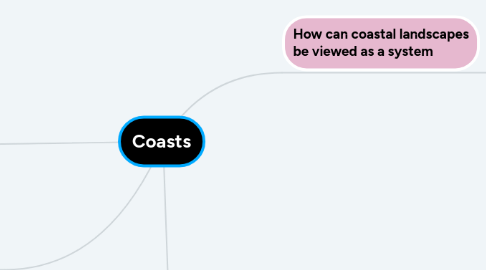
1. How do coastal landforms evolve over time due to climate change
2. How does human activity cause change within the coastal landscape system
3. How can coastal landscapes be viewed as a system
3.1. Coastal landscapes can be viewed as systems
3.1.1. A system is a set of interrelated objects compromising of components and processes that are connected together to form a unified whole
3.1.2. These systems, store and transfer energy and material on time scales that can vary from a few days to a millenia
3.1.3. The energies can be kinetic, thermal or potential
3.1.4. Coastal systems are open, energy and matter can be transferred from neighbouring systems as inputs/outputs
3.1.4.1. Inputs: includes kinetic energy (wind/waves), thermal energy (sun), potential energy (weathering/mass movement)
3.1.4.2. Outputs: including marine and wind erosion and evaporation
3.1.4.3. Throughputs: consist of stores, including beach and earshot sediment accumulations and flows
3.1.5. A system reaches equilibrium when inputs + outputs are =
3.1.5.1. E.g. rate at which sediment is being removed from beach = amount of sediment being added
3.1.5.2. If the system is disturbed, it undergoes self -regulation and changes its form in order to restore the equilibrium = negative feedback
3.1.6. A sediment cell is a stretch of coastline and its associated nearshore area where sediment is mostly self-contained
3.1.6.1. Regarded as a closed system, however unlikely as fine sediment may easily pass through due to wind direction and tidal presence
3.2. Coastal landscape systems are influenced by a range of physical factors
3.2.1. Winds
3.2.1.1. Source of energy for coastal erosion and sediment transport = wave action
3.2.1.2. Wave energy generated by frictional drag of winds moving across ocean surface
3.2.1.3. Higher wind speed + longer fetch = larger and more energy waves
3.2.1.4. Aeolian processes contribute to shaping coastline
3.2.2. Waves
3.2.2.1. Possesses potential energy as a result of its position above the wave trough
3.2.2.2. Moving waves don't move the water forward - the waves create a circular motion to the individual water molecules
3.2.2.3. Wave behaviour is influenced by many factors, e.g. the shape and gradient of the sea floor and the irregularity of the coastline
3.2.2.4. Breaking waves - waves moving into shallow water their behaviour changes
3.2.2.4.1. At this depth the deepest circling water molecules come into with the seafloor
3.2.2.4.2. Friction between the seafloor and water changes the speed, direction and shape of waves
3.2.2.4.3. Spilling waves - steep waves breaking onto gently sloping beaches; water spills gently forward as the wave breaks
3.2.2.4.4. Plunging - Moderately steep waves break onto steep beaches; water plunges vertically downwards as the crest curls over
3.2.2.4.5. Surging - Low angle waves breaking onto steep beaches; the wave slides forward and may not break
3.2.2.4.6. Swash/backwash come fro gravity and always occur perpendicular to the coastline
3.2.2.5. Constructive/destructive waves
3.2.2.5.1. Low in height, long wavelength, low frequency, typically break as spilling waves, strong swash
3.2.2.5.2. Greater height, shorter wavelength, higher frequency, break as plunging waves
3.2.3. Tides
3.2.3.1. Periodic rise and fall of the sea surface and are produced by the gravitational pull of the moon and sun
3.2.3.2. Spring tides
3.2.3.2.1. The highest tides will occur when the moon, sun and earth are all aligned - gravitational pull = strongest
3.2.3.3. Neap tides
3.2.3.3.1. Moon and sun are at right angles to each other - gravitational pull = weakest
3.2.4. Geology
3.2.4.1. Lithology
3.2.4.1.1. The physical and chemical composition of rocks
3.2.4.1.2. Some rocks have weak lithology, little resistance to erosion, weathering and mass movement
3.2.4.1.3. Some rocks are made of dense interlocking crystals, more resistant
3.2.4.1.4. Some rocks are also soluble in weak acids and vulnerable to chemical weathering
3.2.4.2. Structure
3.2.4.2.1. Properties of individual rocks types
3.2.4.2.2. Porous rocks have tiny air spaces - absorb/store water - primary permeability
3.2.4.2.3. Water seeps into limestone because it has lots of joints - secondary permeability
3.2.4.2.4. Joints are easily enlarged by solution
3.2.4.2.5. Rock which runs parallel to the coast = concordant coastline
3.2.4.2.6. Rocks at a 90 degree angle = discordant coastline
3.2.5. Global pattern of ocean currents
3.2.5.1. Nearshore and offshore currents have an influence on coastal landscape systems
3.2.5.2. Rip currents are caused by tidal motion or by waves breaking at right angles to the shore
3.2.5.2.1. After they have formed, they modify the shore profile by creating cusps, helping perpetuate the rip current
3.2.5.3. Ocean currents are on a larger scale, generated by the earths rotation and by convection
3.2.5.3.1. They're set in motion by the movement of winds across the surface of the water
3.3. Coastal sediment is supplied from a variety of sources
3.3.1. Terrestrial
3.3.1.1. Rivers are major sources of sediment input to the coastal budget, where rivers directly deposit their sediments at the coast
3.3.1.1.1. 80% of coastal sediment comes from rivers
3.3.1.2. Origin of the sediment is the erosion of inland areas by water, wind and ice, as well as sub-aerial processes of weathering and mass movement
3.3.1.2.1. Wind erosion is the source of large amounts of sediments and contributes to the coastal sediment budget
3.3.2. Offshore
3.3.2.1. Constructive waves bring sediment to the shore from offshore locations and deposit it - adding to sediment budget - marine deposition
3.3.2.2. Wind also blows sediment from other locations, including reposed sand bars, dunes and beaches elsewhere along the coastline
3.3.2.3. The aeolian material is mainly fine sand, as wind has less energy than water and cannot transport large particles
3.3.3. Human
3.3.3.1. When a coastal sediment budget is in deficit, beach nourishment is the one way in which sediment equilibrium can be maintained
3.3.3.2. Sediment can be bought in through a mode of transportation and be dumped on the beach before being spread out
3.3.3.3. Sediment loss - sediment gain = sediment budget
